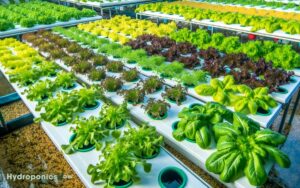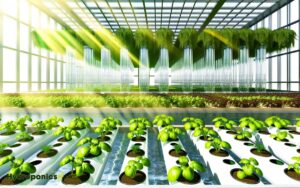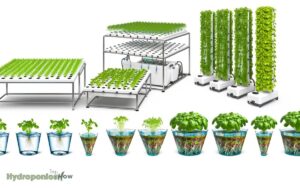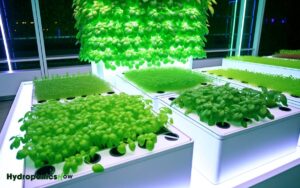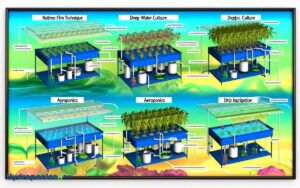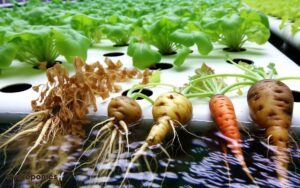5 Steps to Grow Jalapenos Hydroponically: A Full Guide
To grow jalapeños hydroponically, select efficient systems like NFT or DWC.
Choose cultivars such as ‘Early Jalapeño‘ or ‘Jalafuego’ based on yield and disease resistance. Set up with essential equipment including grow lights, water pumps, and nutrient solutions.
Maintain pH balance around 5.8-6.3 and manage light exposure for 14-16 hours daily. Ideal temperatures range between 70-85°F during the day and 60-70°F at night.
Proactively monitor for pests and nutrient imbalances. Harvest when fruits reach desired size and coloration, checking Scoville Heat Units for spiciness.
For detailed guidance, explore specific nutrient schedules and environmental controls.
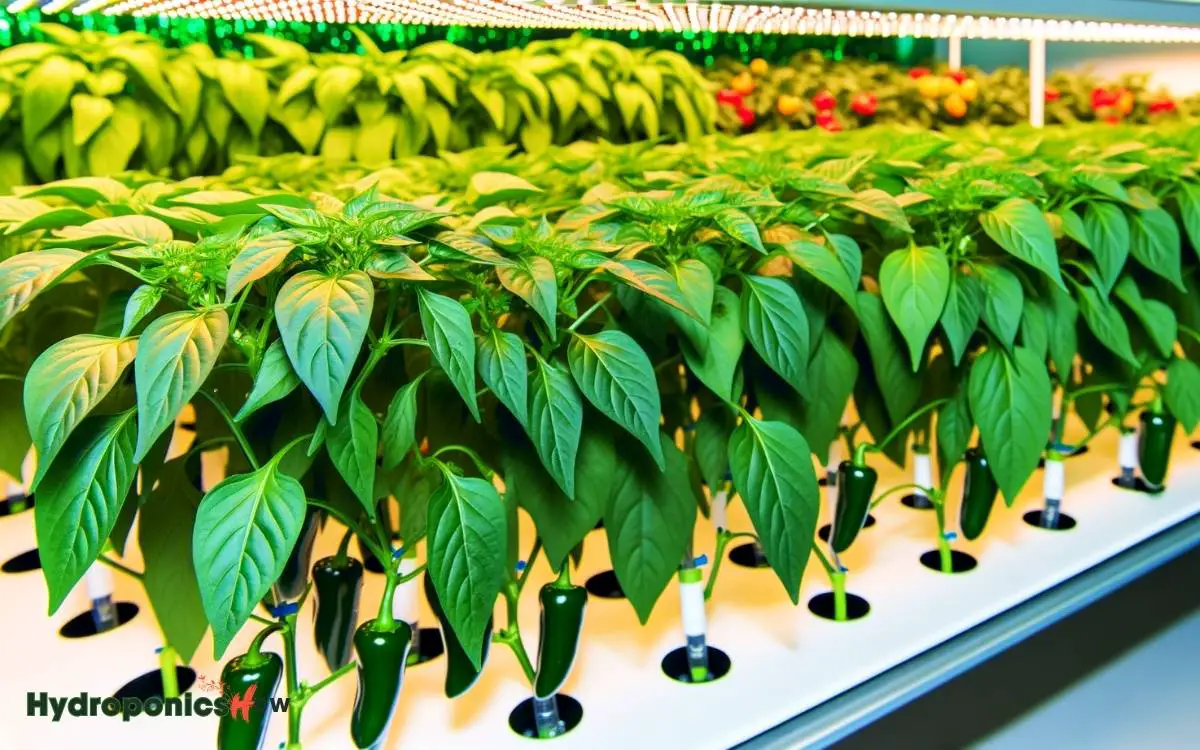
Key Takeaways
Choosing Your Hydroponic System
Choosing the right hydroponic system is crucial for maximizing the growth and yield of jalapenos in a controlled environment.
Among the various hydroponic systems, Nutrient Film Technique (NFT) and Deep Water Culture (DWC) offer high efficiency for jalapeno cultivation.
NFT provides a continuous flow of nutrient solution over the plant roots, guaranteeing ideal nutrient uptake, while DWC suspends plant roots in oxygen-rich, nutrient-laden water, promoting rapid growth.
Data indicates that jalapenos grown in DWC can achieve up to 25% faster growth rates compared to soil.
Key parameters such as pH (5.5-6.5), electrical conductivity (1.8-2.2 mS/cm), and dissolved oxygen levels (5-8 mg/L) must be closely monitored to maintain an ideal growing environment.
Selecting Jalapeño Varieties
When selecting jalapeño varieties for hydroponic cultivation, it is essential to assess popular cultivars such as ‘Early Jalapeño‘ and ‘Jalafuego‘, known for their performance and yield.
Evaluating heat levels, measured in Scoville Heat Units (SHU), is vital as it impacts both consumer preference and marketability.
Additionally, understanding growth habit differences, including plant height and branching patterns, can optimize space utilization and system compatibility in a hydroponic setup.
Popular Jalapeño Varieties
Selecting the best jalapeño variety for hydroponic cultivation requires a thorough understanding of each variety’s growth characteristics, yield potential, and disease resistance.
Varieties such as ‘Early Jalapeño‘ and ‘Jalafuego‘ are remarkable due to their robust growth in controlled environments.
‘Early Jalapeño’ matures in approximately 65 days, providing a quick turnover. Meanwhile, ‘Jalafuego‘ offers high yields and excellent disease resistance, making it suitable for intensive cultivation. ‘Purple Jalapeño‘ adds aesthetic value while maintaining a reliable yield.
Data indicates that ‘Biker Billy‘ thrives in hydroponic systems with its compact growth habit. Selecting an optimal variety involves evaluating specific needs, including space constraints and desired production rates, ensuring a productive and sustainable hydroponic jalapeño operation.
Heat Level Considerations
Evaluating the heat level of jalapeño varieties is crucial for aligning crop characteristics with consumer preferences and market demands in hydroponic cultivation.
The Scoville Heat Unit (SHU) scale is the primary metric for quantifying capsaicin concentration, ranging from 2,500 to 8,000 SHUs for standard jalapeños.
Cultivators should consider varieties like ‘Jalafuego,’ which averages higher SHUs, or ‘TAM Mild,’ which offers a milder profile, typically under 3,500 SHUs.
Data from controlled hydroponic environments indicate that nutrient solution composition, pH levels, and light exposure can greatly influence capsaicin synthesis.
Therefore, precise environmental monitoring and genetic selection are crucial for achieving desired heat levels, ensuring product consistency, and meeting specific market requirements.
Growth Habit Differences
Understanding the growth habit differences among jalapeño varieties is essential for optimizing spatial planning and resource allocation in hydroponic systems.
Varieties such as ‘Early Jalapeño‘ and ‘Jalafuego‘ exhibit compact, bushy growth, making them suitable for vertical hydroponic setups with limited horizontal space.
Conversely, ‘Jalaro‘ and ‘Goliath‘ varieties have a more sprawling habit, necessitating additional space and support structures.
Data indicates that compact varieties generally have a higher yield per square meter, enhancing overall system efficiency.
Analytical evaluation of plant architecture, including internodal length and branching patterns, allows for precise tailoring of nutrient delivery and light exposure.
Selecting the appropriate jalapeño variety based on growth habit is important for maximizing productivity and resource efficiency in hydroponic cultivation.
Setting Up the System
Setting up an efficient hydroponic system for jalapeños necessitates the careful selection of appropriate equipment and precise preparation of nutrient solutions.
Choosing the correct hydroponic equipment, such as grow lights, water pumps, and grow trays, guarantees ideal plant growth conditions. Selecting high-quality components ensures that plants receive the necessary light, water, and nutrients for healthy development. For example, a fish tank hydroponic system can be an excellent choice for integrating aquaponics, where fish waste provides natural nutrients for plants. This sustainable approach reduces the need for chemical fertilizers while maintaining an optimal growing environment.
Moreover, the nutrient solution must be meticulously formulated to provide the essential macro and micronutrients required for robust jalapeño development.
Choosing Hydroponic Equipment
Selecting the ideal hydroponic equipment is essential for ensuring the efficient growth and yield of jalapenos in a controlled environment.
Begin with high-quality grow lights, such as LED or HID systems, which provide the necessary light spectrum for photosynthesis.
Choose a hydroponic system that suits your space and budget popular options include Deep Water Culture (DWC), Nutrient Film Technique (NFT), and Aeroponics.
Make sure the system includes reliable pumps and timers to maintain the best water and nutrient delivery.
Monitoring tools, such as pH and EC meters, are important for maintaining the precise conditions required for jalapeno plants.
Invest in durable growing mediums like Rockwool or clay pebbles that support root development and nutrient absorption efficiently.
Nutrient Solution Preparation
Facilitating peak growth of jalapenos in a hydroponic system necessitates meticulous preparation of the nutrient solution, tailored to meet the specific nutritional needs of the plants.
Key macro-nutrients nitrogen (N), phosphorus (P), and potassium (K) should constitute the foundational elements, with a balanced N-P-K ratio around 3-1-4 for best growth.
Micro-nutrients such as magnesium, calcium, and iron must be precisely measured, maintaining concentrations at 50-100 ppm for calcium and 1-2 ppm for iron.
Regular monitoring of the electrical conductivity (EC) and pH levels is crucial, with ideal pH maintained between 5.5 and 6.0, and EC between 1.8 and 2.2 mS/cm.
This precise nutrient calibration ensures robust plant health and high yield in hydroponically grown jalapenos.
Nutrients and Feeding Schedule
An ideal nutrient solution for hydroponically grown jalapenos must be meticulously balanced to support vigorous growth and high yield. The nutrient regimen should guarantee ideal levels of macronutrients and micronutrients.
Key elements include nitrogen (N), phosphorus (P), and potassium (K), supplemented by calcium (Ca), magnesium (Mg), and trace elements like iron (Fe) and zinc.
A recommended feeding schedule can be outlined as follows:
- Seedling Stage: Low nutrient concentration (EC 0.8-1.2 mS/cm), feeding twice a day.
- Vegetative Stage: Moderate nutrient concentration (EC 1.5-2.0 mS/cm), feeding thrice a day.
- Flowering Stage: Higher nutrient concentration (EC 2.0-2.5 mS/cm), feeding four times a day.
- Fruiting Stage: Maintain high nutrient concentration, adjust based on plant response.
Regular monitoring ensures nutrient balance and plant health.
Light and Temperature Control
Proper light and temperature control are crucial factors in maximizing the growth and productivity of hydroponically grown jalapenos.
Light intensity should be maintained at 14-16 hours per day, utilizing high-efficiency LED grow lights that provide a full spectrum, mimicking natural sunlight.
Jalapenos thrive in temperatures between 70-85 °F (21-29 °C) during the day and slightly cooler nights at 60-70 °F (15-21 °C).
Consistent temperature regulation can enhance photosynthetic efficiency and prevent thermal stress. Employ thermostats and timers to automate the light and temperature settings, ensuring precise environmental conditions.
Monitoring tools like digital thermometers and light meters can offer real-time data, facilitating immediate adjustments.
Optimum light and temperature conditions play a key role in robust plant development and higher yields.
Managing Ph Levels
Maintaining the ideal pH level between 5.5 and 6.5 is essential for the nutrient uptake and overall health of hydroponically grown jalapenos. Deviations from this range can impair the plant’s ability to absorb essential nutrients, leading to deficiencies and stunted growth.
To manage pH levels effectively, consider the following steps:
- Regular Monitoring: Use a reliable pH meter to check the nutrient solution daily.
- Adjusting Solutions: Utilize pH-up or pH-down solutions to fine-tune the pH levels as needed.
- Buffer Solutions: Incorporate buffer solutions to stabilize pH fluctuations.
- Water Quality: Make sure the water source has a stable pH and minimal impurities.
Adhering to these practices ensures ideal conditions for jalapeno growth and maximizes yield.
Pest and Disease Prevention
Effective pest and disease prevention in hydroponically grown jalapenos involves a combination of proactive monitoring, environmental controls, and the use of organic or chemical treatments as necessary.
Regular inspection for early signs of infestation is essential; this can be facilitated through integrated pest management (IPM) techniques, which emphasize early detection and targeted intervention.
Environmental controls, such as maintaining ideal humidity levels (40-60%) and ensuring adequate airflow, can greatly reduce the risk of fungal and bacterial diseases.
Data-driven approaches, including the use of sensors and automated systems, help maintain consistent environmental conditions.
When intervention is necessary, choose treatments that are specific to the identified pests or pathogens, ensuring minimal impact on plant health and yield. This multi-faceted approach ensures robust pest and disease management.
Harvesting Your Jalapeños
Harvesting jalapeños at the key stage of maturity is essential for maximizing flavor, nutritional value, and overall yield.
To achieve best results, it is important to monitor the following parameters:
- Color: Harvest when jalapeños turn from a bright green to a darker green or red, indicating full maturity.
- Size: Ideal jalapeños measure between 2 to 3 inches in length, ensuring the peppers have developed fully.
- Texture: A firm but slightly yielding texture signifies readiness; overly soft peppers may be overripe.
- Capsaicin Levels: Measure Scoville Heat Units (SHU) to maintain desired spiciness, typically ranging between 2,500 to 8,000 SHU.
Conclusion
To summarize, the meticulous cultivation of jalapeños through hydroponic methods reveals a symphony of precision and science.
By carefully selecting systems and varieties, maintaining ideal nutrient levels, and vigilantly managing environmental conditions, one can achieve a bountiful harvest.
The orchestration of these elements culminates in robust, flavorful jalapeños, underscoring the effectiveness of hydroponic agriculture.
Therefore, the hydroponic approach not only maximizes yield but also guarantees the consistent quality of the produce, highlighting its potential in modern horticulture.

